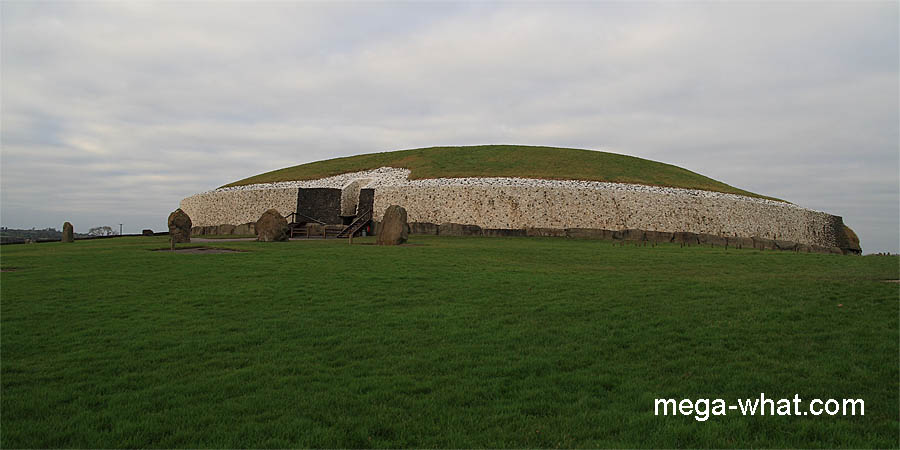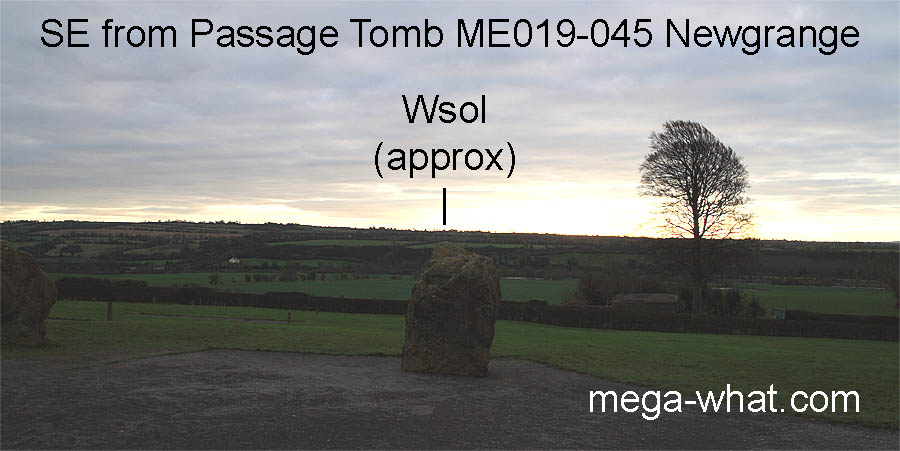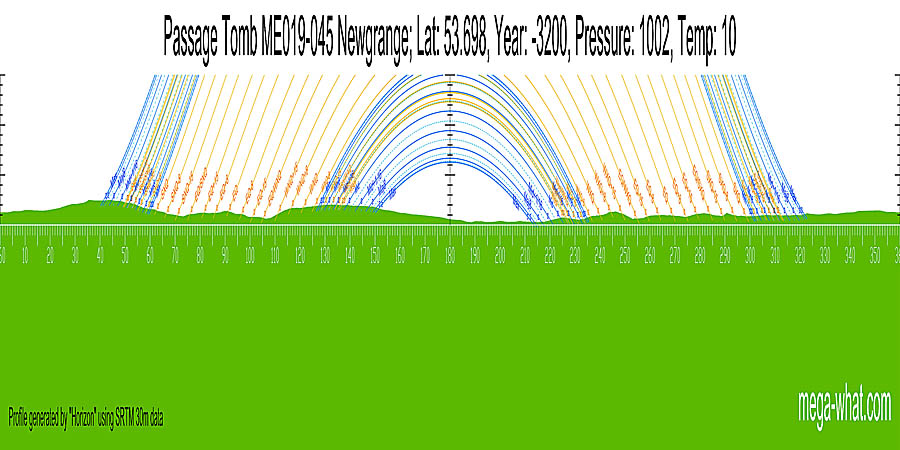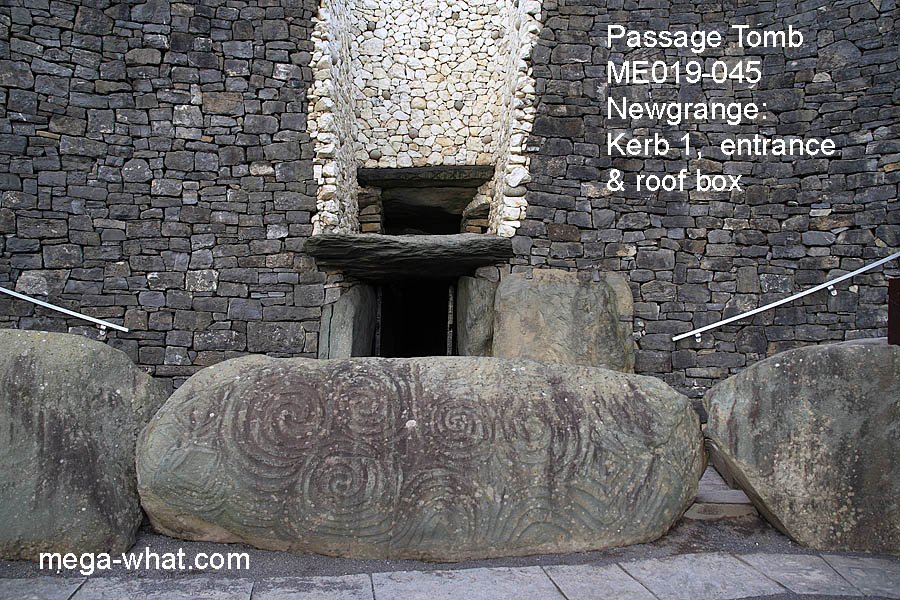In celtic folklore Newgrange was the palace of the Irish god of love, Angus Óg (Angus the Young). He was son of the Dagda Mór (great good god) by the goddess Boanna (the river Boyne). It can be found in Co. Meath, south of the N51 between Drogheda and Slane where access is via the visitor centre.
Newgrange Passage Tomb is certainly the most famous megalithic tomb in Ireland, probably the world, because a beam of sunlight shines into its passage at winter solstice sunrise and it is about 5000 years old. Older than the Egyptian pyramids it is both a National Monument and a World Heritage Site. Its "solstitial" alignment is not at all unique though - see Knockroe Passage Tomb or Stoney Littleton Longbarrow for example.
Much has been written about the archaeoastronomy of Newgrange but the real significance of its solstitial light beam has not previously been recognised...
 The cruciform passage is 24m long and covered by a mound 85m across.
It was excavated between 1962 & 1975 (O'Kelly 1982) and a number of 14C dates were obtained.
Two of them date the construction, placing it at 2470bc (about 3200 cal.B.C.).
The circle of intermittent Standing Stones around the mound are thought to be later, Bronze Age, additions to the site.
The cruciform passage is 24m long and covered by a mound 85m across.
It was excavated between 1962 & 1975 (O'Kelly 1982) and a number of 14C dates were obtained.
Two of them date the construction, placing it at 2470bc (about 3200 cal.B.C.).
The circle of intermittent Standing Stones around the mound are thought to be later, Bronze Age, additions to the site.
On the winter solstice of 1967 rumours of the penetration of the tomb by a beam of light were confirmed by observation. Because of the upward slope of the passage, light entering the entrance cannot reach the chamber but a slot or 'roof-box' had been built into the roof specifically to allow a beam of light to do so.
 This photo shows Newgrange tomb entrance and the roof-box above it. Note that the concave curves of grey limestone either side of the entrance were built to facilitate visitor access.
Originally the sides of the mound would have made convex curves towards the entrance.
O'Kelly's reconstruction of the facade was indeed very controvertial at the time but all the quartz was found at the foot of the mound, eroded and overgrown as it was.
This photo shows Newgrange tomb entrance and the roof-box above it. Note that the concave curves of grey limestone either side of the entrance were built to facilitate visitor access.
Originally the sides of the mound would have made convex curves towards the entrance.
O'Kelly's reconstruction of the facade was indeed very controvertial at the time but all the quartz was found at the foot of the mound, eroded and overgrown as it was.
Dr Jon Patrick was asked to survey the light beam phenomenon and O'Kelly (1982:124) quotes this extract from his report (Patrick 1974:518-519):
The passage is in the form of two curves so that for a ray of light to travel directly from the roof-box to the back wall of the rear recess it must be in the azimuth range 133°42'-138°24'. The elevation of the distant horizon (0°51') is the minimum elevation at which the sun's direct rays can enter the slit. The floor of the chamber is about 15cm lower than the roof-box, so at the minimum elevation sunlight will extend across the floor and into the rear recess. Light rays will not enter the chamber when the elevation exceeds about 1°40'. This range of azimuths and elevations, reliable to about 15' and 5' respectively, means that the sun's rays will shine directly into the chamber if its declination lies between -22°58' and -25°53'. It therefore seems that the sun [in theory] has shone [into] the chamber ever since the date of its construction and will probably continue to do so for ever, regardless of secular changes in the obliquity of the ecliptic. It also means that the spectacle occurs for a number of days before and after the winter solstice.Unfortunately, the vagaries of time have had their effect on the passage and some of the stones are now leaning inwards, thus trimming down the width of the beam of light. At the time of construction the beam would have been about 40cm wide whereas now it is only 17cm. The two principle orthostats causing the obstruction are L18 and L20. The first ten orthostats on either side of the passage have been straightened but there is no way of straightening the rest without dismantling the whole structure.
The roof-box is 90cm high, 1.2m deep and 1m wide, therefore it seems probable that outside the limiting declinations given above, the light beam would play on the passage walls. Whether or not this could have any additional significance remains unknown.
The limiting declinations are significant:
- -22°58' is -22.96°. This is Wsol+15, in other words the limit of a month centred on the solstice.
Also effectively the lunar sixteenth on the minor side of the midpoint.
- -25°53' is -25.88°. Well beyond the solstice which was about -24.02° at time of construction. In lunar terms it is very close to Mid+1/32, the delimiter between periods centering on lunar midpoint and the sixteenth on the major side of the midpoint.
So the beam of sunlight was actually intended to shine into the chamber for a period, centred on the solstice, of exactly one month and thus to accurately define the time during which the full-moon nearest the solstice must occur. This full moon could be expected to eclipse in the year that the moon was at the midpoint of its cycle. It is also possible for it to eclipse during periods centred on the sixteenths adjacent to the lunar midpoint provided that the full moon is a week or more away from the solstice. The moon would also create a weaker beam that would shine into the chamber during the period around the lunar midpoint. Times for observing this are south lunisticeLunistices are the most northerly and southerly moons of the month. The lunar equivalent of solstices - more. rises between spring equinox and summer solstice.
O'Kelly mentions (1982:22) that that the part of the passage entrance incorporating the roof-box was built as a free-standing structure, independent of the remainder of the passage. It seems likely that this was done so that it could be tested before the rest of the tomb was built: Thus ensuring that the rear chamber could correctly receive the light beam and allowing the correct positions of structural elements in the passage to be determined.
 The south-eastern horizon is relatively featureless compared with the remainder, as may be seen from this photo.
This is a possible reason for the use of a light beam to indicate the month centred on the winter solstice and the period centred on the lunar midpoint.
The south-eastern horizon is relatively featureless compared with the remainder, as may be seen from this photo.
This is a possible reason for the use of a light beam to indicate the month centred on the winter solstice and the period centred on the lunar midpoint.
Newgrange is the central tomb of three in the bend of the Boyne river, the other two being Knowth and Dowth. All three are much larger than normal passage tombs, of which there are also a number in the same area, many predating the large tombs. It is likely that these three were built by a very wealthy society and while it seems probable that they utilise the traditional siting and orientational criteria for their type, they may possibly display unusual features.
Of the ninety-three kerbstones around the perimeter of Newgrange, only three are fully decorated with Passage Tomb Art.
- Kerb 1 is the stone outside the entrance and thus faces winter solstice sunrise. This is the one with the triple spiral.
- Kerb 52 is diametrically opposite the entrance. It reputedly faces Knowth and the north-west lunar minor standstillLunistice positions vary cyclically over an 18.6 year period but are fairly static for more than a year at either end of the range (Brennan 1994, 70-73). Tap/Click here to see the view from it.
- Kerb 67 is on the north-east side and reputedly faces summer solstice sunrise (Brennan 1994, 192) Tap/Click here to see the view from it.
 The view shown here was created using horizon data generated by a computer program using topographic data from NASA and should be regarded as indicative rather than accurate.
The algorith seems to be good but the base data is insufficiently precise for certainty. Nonetheless, the horizon profile does seem to be very useful in a luni-solar calendrical sense.
The view shown here was created using horizon data generated by a computer program using topographic data from NASA and should be regarded as indicative rather than accurate.
The algorith seems to be good but the base data is insufficiently precise for certainty. Nonetheless, the horizon profile does seem to be very useful in a luni-solar calendrical sense.
References
- Archaeological Survey of Ireland, record details. www.archaeology.ie/archaeological-survey-ireland
- http://www.worldheritageireland.ie/bru-na-boinne/visitor-information
- BRENNAN, MARTIN 1994 The Stones of Time. Vermont: Inner Traditions International. (First Published 1983 The Stars and the Stones. London: Thames & Hudson.)
- MOORE, MICHAEL J. 1987 Archaeological Inventory of County Meath. Dublin: Stationary Office. p18, no.50.
- O'KELLY, MICHAEL J. 1982 Newgrange. London: Thames & Hudson.
- PATRICK, J. 1974 Midwinter sunrise at Newgrange. Nature 249:517-519.
- Cahill, M + Lynch, A + O'Brien, W + Shee Twohig, E 2016/12/24 Irish Times letters re: the roof box
- A.G.K. Smith "Horizon" computer program for windows
- Derek Watkins 30-Meter SRTM Tile Downloader
- NASA Shuttle Radar Topography Mission

